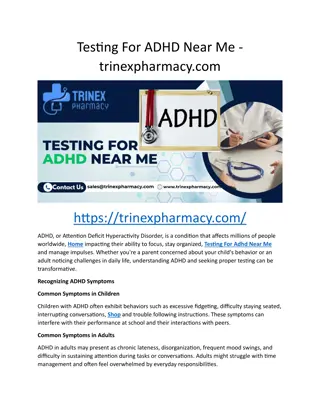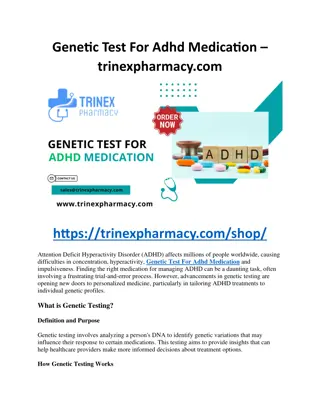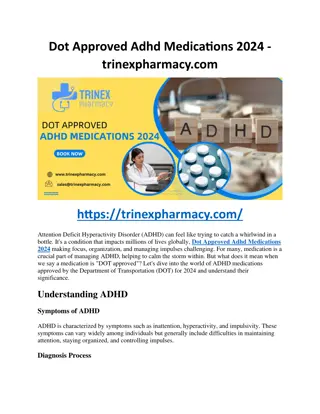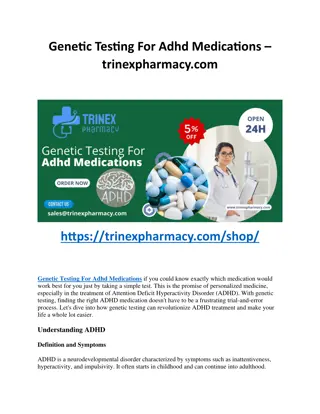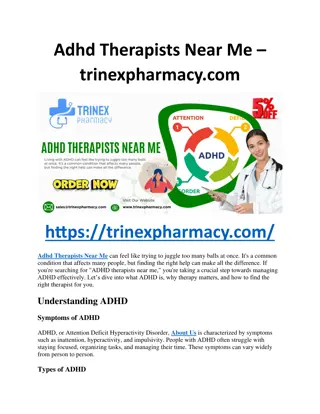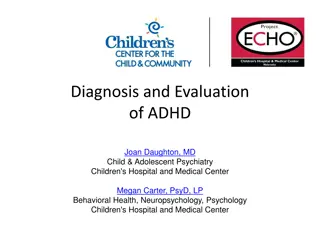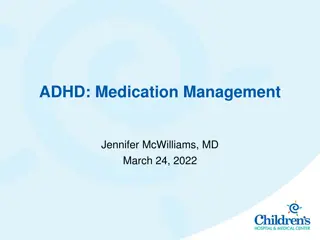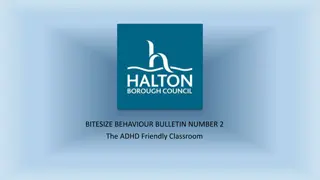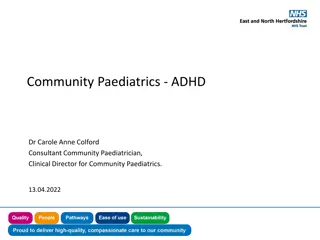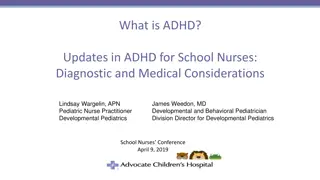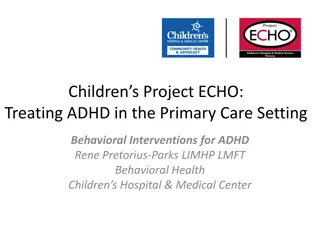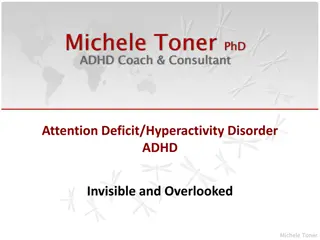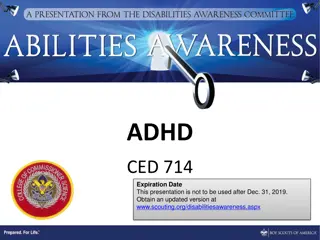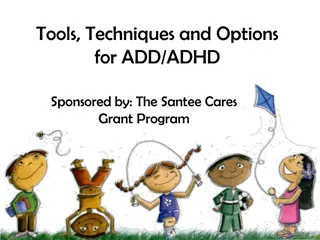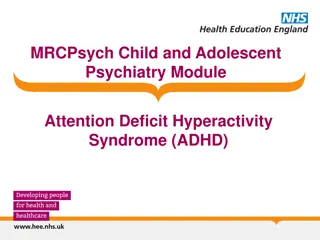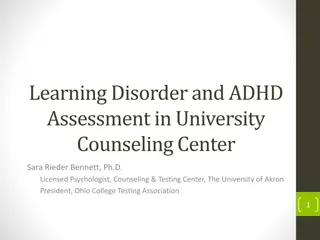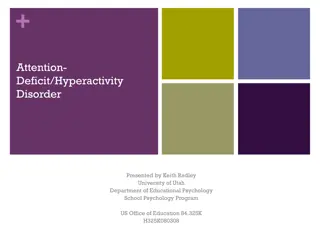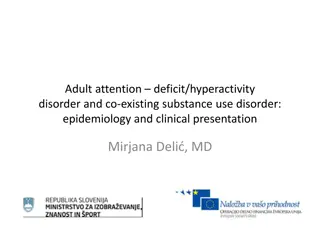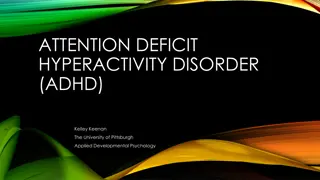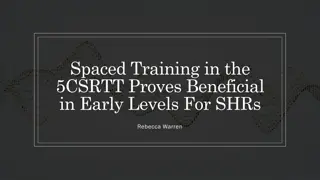Understanding the Complex Relationship between ADHD and Addictions
Appreciate the intricate evolution of Attention Deficit Hyperactivity Disorder (ADHD) in relation to addictions. Explore clinically relevant science and care management principles for managing co-occurring ADHD and substance use. ADHD and addictions are clinical diagnoses with no definitive tests, highlighting the importance of understanding symptom criteria and relevant histories. Dive into the clinical presentation of ADHD, emphasizing the neurobiological basis and developmental factors.
Download Presentation

Please find below an Image/Link to download the presentation.
The content on the website is provided AS IS for your information and personal use only. It may not be sold, licensed, or shared on other websites without obtaining consent from the author. Download presentation by click this link. If you encounter any issues during the download, it is possible that the publisher has removed the file from their server.
E N D
Presentation Transcript
J.J. Rasimas, Ph.D., M.D. Professor of Psychiatry & Emergency Medicine Dalhousie University, University of Minnesota, & Penn State College of Medicine C-L Psychiatry and Addictions, Queen Elizabeth Hospital, Charlottetown, PE 1
I have no relevant conflicts of interest around treatments or financial interests related to them While I have greater exposure to the care of children than a general psychiatrist, including two years of supervision under a child psychiatrist, I am not board certified in CAP I have formal certification in addiction medicine and medical toxicology both make me more attuned to negative consequences of ingesting things, not automatically prone to see medicines as therapeutic 2
Appreciate aspects of the complex evolution of Attention Deficit Hyperactivity Disorder (ADHD) relevant to addictions Understand clinically applicable science and care management principles useful in navigating risks and benefits of treatment of co-occurring ADHD and substance use 3
ADHD and Addictions are Clinical Diagnoses No confirmatory diagnostic tests No validation outside the assessment(s) of clinician(s) Expert clinicians agree less than 50% of the time (?) Symptom criteria and their relevant histories define disorders Symptom overlap is common (ADHD and Addictions) Terminology does not standardize meaning Regier, et al. AJP 2013. 4
Clinically Some combination of severe inattention, hyperactivity, and impulsivity that begins in childhood, and often persists into adulthood Must cause functional impairment across settings, and must be developmentally relevant Symptoms must be present before age 7 Neurobiologically A condition of abnormal central neurologic development partially determined by genetics Differences in brain morphology reflect neurodevelopment that can be altered by nurture and treatment Spinelli, et al. JAACAP 2011. Ogrim, et al. Psych Res 2012. 5
Peak cortical thickness for ADHD and healthy controls: ADHD shift to the right Shaw et al. Attention-deficit/hyperactivity disorder is characterized by a delay in cortical maturation. PNAS, 104(49): 19649-19654
Diagnosis is observer-based Rater bias (including agendas desirous of answers) With input from multiple sources (parents, teachers, etc.) reliability is moderate Connors or other tools can help Criteria modification with increasing age is not standard Retrospective views of symptoms by adults, especially without collateral information are even less reliable Especially when reported by an individual who has current suffering and a wish for treatment to soothe it 8
Like all things in medicine, early recognition and intervention for ADHD is best Recommendations are grouped by age 4 to 5, behaviour therapy is first line Tx. 6 to 11, stimulant medication AND behaviour therapy, along with accommodations at school to address special needs. 12 to 18, medication with the teen s consent and participation, AND behaviour therapy. Psychostimulants are the most efficacious AND come with the greatest potential for adverse effects Atomoxetine, viloxazine, bupropion, TCAs, SSRIs Clonidine / Guanfacine typically adjunctive (hyperactive subtype) American Academy of Pediatrics Wang, et al. Plos One 2013. 9
Large studies of clinically applicable populations indicate childhood Rx with stimulants does not cause addiction Robust treatment for ADHD in childhood reduces the risk of development of clinically evident addictive illness Up to 50% in youth At least 15% (perhaps up to 60%) in adolescents / adults Addictive disorders have genetic determinants that can alter risk-benefit profiles with substandard treatment. Faraone & Wilens. JCP, 2013. Chang, et al. JCPP 2014. McCabe, et al. JAACAP 2016. 10
Psychostimulant mechanism strikes a key chord in the limbic music of emotion, reward, and addiction Increase the amount and persistence of monoamines (dopamine, norepinephrine, even serotonin) in synaptic clefts Blockade of DA and NE transporters (reuptake) Enhance release of catecholamines from presynaptic vesicles 11
Seek an accurate diagnostically-relevant history for ADHD Distinguish withdrawal anxieties, sleep inefficiencies, and other substance-related symptoms Screen also for comorbid conditions with overlapping symptoms PTSD Anxiety Disorders Mood Disorders (both depression and (hypo)mania) Psychosis Mariani & Levin. AM J Addict 2007. 12
Full remission (21%) Partial (42%) No improvement (37%) Longitudinal NIH Cohort Followed ~ 2 decades Giedd, 2010. 13
Typically Developing Cortical Thickness (mm) Good Outcome Poor Outcome Age (yrs) Giedd, 2010.
Evidence base is not solid Clinical expertise and prudence define guidelines Retain principles of therapy from youth treatment Atomoxetine, viloxazine (NRIs) make the most mechanistic sense TCAs, SNRIs, SSRIs Bupropion (NDRI) Modafinil Clonidine / Guanfacine Mariani & Levin. AM J Addict 2007. 15
Methylphenidate rational first choice of compound Utility of routine urine screening immunoassays Preparations are not well-protected against diversion All other stimulants are close structural analogs with basic amphetamine Lisdexamfetamine may be the best choice to avoid diversion Methamphetamine Mariani & Levin. AM J Addict 2007. 16
Methylphenidate Dopamine Norepinephrine Methamphetamine Amphetamine Bupropion (Wellbutrin) 17
29 y/o man substance use history Delivered by police after neighbors called Loud disturbance, pounding on walls Found shirtless, violent with police Restrained Multiple doses of sedative medication Elevated body temperature and blood pressure Evidence of kidney damage and heart stress Three days in ICU Paranoia robot rats in the walls at home Took Crystal Meth to Get sh** done Antipsychotic medications given Inpatient Psychiatry Transferred to inpatient addiction recovery weeks later 18
Crosses into and stays in the brain longer than cocaine and other stimulants Depletes nerve cells of dopamine and other transmitters Rush of these chemicals cause the high Psychosis and dysregulated behaviour Overstimulation and subsequent lack of transmitters, nutrients, and integrity causes stress on nerve cells sometimes to the point of death 19
Memory, concentration, impulse control, judgment Greater risk of dementia (earlier) Anxiety, Depression, Psychosis Paranoia, Formication Uncontrolled and / or repetitive movements Punding (purposeless compulsions) Dental caries, bruxism (jaw clenching/grinding), acne / skin breakouts, heart and lung disease, 20
Scylla Charybdis 21
Early recognition and treatment for ADHD prevents the development of substance use disorders Alcohol, cannabis, stimulants, and even sedatives / opioids First line treatment is stimulant medication Once addiction has taken hold, patients need to participate in psychotherapies to recover Untreated ADHD symptoms may obstruct the process Prescribing stimulants may fuel addiction and / or exacerbate other psychiatric problems (e.g. psychosis) Nonstimulant medications are first-line but often work less well 22
Jay Giedd, M.D. NIH / UCSD J. Ward Donovan, M.D. Penn State / Pinnacle Toxicology Dan Rusyniak, M.D. Indiana University Charlie Reznikoff, M.D. Hennepin County Medical Center erowid.org COMMENTS / QUESTIONS ??? 23
Endogenous phenethylamines are derivatives of tyrosine Dopamine Norepinephrine Exogenous phenethylamines Stimulate dopamine and noradrenergic receptors Stimulate catecholamine release Stimulate serotonin receptors 25
Lipophilic substitution of the side chains of this core ephedrine structure is associated with varying degrees of hallucinogenic and stimulatory effect. 26
Stimulants: 1 inhibitors 2 substrates Serotonergic Neuron Monoamines Psychedelics: 3 5-HT2A agonists 2 (SND) RIs Rx Psychotropics: 4 Reuptake inhibitors 4 MAT 1 Cocaine LSD 3 MDMA 5-HT2 receptors 27
Stimulant Binge Architecture 14 12 10 8 Intensity 6 4 2 0 Time 1 Time 2 Time 3 Time 4 Euphoria Dysphoria Toxicity 28
Early binge Mid-binge Toxicity Alert Sexy/flirtatious Energetic Confident Chatty Awake Euphoric Vigilant Adventurous Jittery Bold Verbose Up late Need a bump Paranoid Hypersexual Agitated Aggressive Pressured Insomniac Dysphoric 29
Crack Cocaine Meth 30 min 2 hours 8 hours 12 36 5 days hours hours 30
Impact of use of meth and newer designer stimulant drugs on brain function and mental health make it difficult to engage patients in standard addiction treatment Cognitive impairments, impulse control problems, paranoia, etc. No current evidence-based medication treatments for addiction to stimulants Unlike alcohol, opioids Comorbid Attention-Deficit Hyperactivity Disorder (ADHD) Pre-existing illness vs. similar impairments caused by drug use 31



